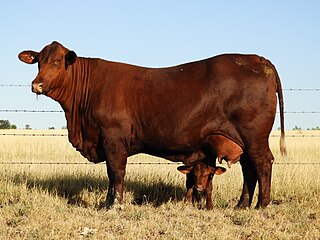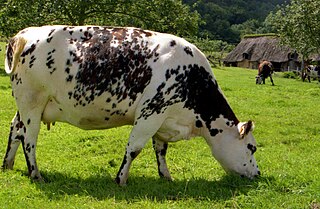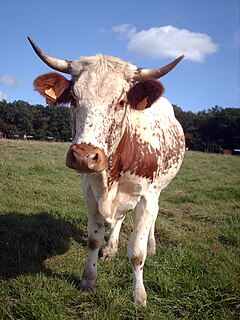
The Dairy Shorthorn is a British breed of dairy cattle. It derives from the Shorthorn cattle of Tees-side, in the North Riding of Yorkshire and in Northumbria in north-eastern England. The Shorthorn was for this reason at first known as the Durham or Teeswater.

The Mishima is a critically-endangered Japanese breed of beef cattle. It is found only on Mishima Island, some 50 km north-west of Hagi, in Yamaguchi Prefecture, Japan. It is one of six native Japanese cattle breeds, and one of two small populations that have never been cross-bred with Western cattle, the other being the Kuchinoshima breed from Kuchinoshima island in the Tokara Island group.

The Santa Gertrudis is an American breed of beef cattle. It is a taurine-indicine hybrid breed, descended from both zebu and European cattle. It was bred in the early twentieth century in Texas, and received official recognition in 1940. It has been exported to many countries including Australia, Brazil and South Africa, and has contributed to the development of a number of modern breeds, among them the Barzona and the Droughtmaster.

The Normande is a breed of dairy cattle from the Normandy region of north-west France. It is raised principally for its milk, which is high in fat and suitable for making butter and cheese, but also for its meat, which is marbled and good-flavoured. It is a world breed: it has been exported to many countries and is present on all continents.

The Pinzgauer is a breed of domestic cattle from the Pinzgau region of the federal state of Salzburg in Austria. It has distinctive colouring, with chestnut-brown sides and white back and underside. It was in the past a triple-purpose breed, raised for meat, milk and draught use. There is a naturally polled sub-type, the Jochberg Hummel. In 2007 the breed was not considered by the FAO to be at risk.

The Japanese Black is a breed of Japanese beef cattle. It is one of six native Japanese cattle breeds, and one of the four Japanese breeds known as wagyū, the others being the Japanese Brown, the Japanese Polled and the Japanese Shorthorn. All wagyū cattle derive from cross-breeding in the early twentieth century of native Japanese cattle with imported stock, mostly from Europe. In the case of the Japanese Black, the foreign influence was from European breeds including Braunvieh, Shorthorn, Devon, Simmental, Ayrshire and Holstein.
The Abyssinian Shorthorned Zebu is an Ethiopian breed or group of breeds of zebuine cattle. It is not reported to DAD-IS as a breed.

The Japanese Brown is a breed of small Japanese beef cattle. It is one of six native Japanese cattle breeds, and one of the four Japanese breeds known as wagyū, the others being the Japanese Black, the Japanese Polled and the Japanese Shorthorn. All wagyū cattle derive from cross-breeding in the early twentieth century of native Japanese cattle with imported stock, mostly from Europe. In the case of the Japanese Brown, the principal foreign influence was from the Korean Hanwoo and Swiss Simmental breeds.

The Armoricaine or Armorican is an endangered French breed of domestic cattle. It originated in Brittany in the nineteenth century. It has a red coat with white markings, and has short horns.

The Droughtmaster is an Australian breed of beef cattle. It was developed from about 1915 in North Queensland by crossing zebuine cattle with cattle of British origin, principally the Beef Shorthorn. It was the first Australian taurindicine hybrid breed; it is approximately 50% Bos indicus and 50% Bos taurus.

The Ferrandaise is an endangered French breed of domestic cattle from the département of Puy-de-Dôme, in the Massif Central mountains of Auvergne, in central France. It is named for the city and commune of Clermont-Ferrand, the capital of Puy-de-Dôme.
Miniature cattle are found in various parts of the world. Some, such as the Dexter of Ireland and the Vechur of Kerala, India, are traditional breeds; others have been recently created by selective breeding. The Australian Lowline was the unexpected result of a scientific experiment. Some, but not all, miniature breeds display achondroplasia, or dwarfism.

The Fjäll is a traditional Swedish breed of polled mountain cattle. It was threatened with extinction in the 1970s and 1980s, but recovered after a breed association was formed in 1995, partly thanks to stocks of frozen semen. Microsatellite analysis has shown it to be closely related to the endangered Bohuskulla breed.
The Blue Albion was a British breed of cattle with an unusual blue roan coat. It originated in the English Midlands in the late nineteenth or early twentieth century, and was a dual-purpose breed, reared both for beef and for milk. It became extinct following the foot-and-mouth outbreak of 1967.

The Swedish Red-and-White, Swedish: Svensk Röd och Vit Boskap, frequently abbreviated to SRB, is a Swedish breed of dairy cattle. It was created in the 1920s by crossing the Swedish Red Pied and Swedish Ayrshire breeds.
The Swedish Red Pied, Swedish: Rödbrokig Svensk Boskap, frequently abbreviated to RSB, was a Swedish breed of dairy cattle. It is now considered extinct. It was merged in the 1920s with the Swedish Ayrshire breed to create the Swedish Red-and-White, which is one of the principal dairy breeds of Sweden.

The Väneko is an endangered Swedish breed of dairy cattle. It is named for the village of Väne-Ryr in the landskap of Västergötland, in western Sweden. It is a traditional domestic Swedish breed, and derives from a group of cattle discovered in the 1990s, at a time when all traditional Swedish horned cattle were thought to have disappeared.
The Japanese Shorthorn is a breed of small Japanese beef cattle. It is one of six native Japanese cattle breeds, and one of the four Japanese breeds known as wagyū, the others being the Japanese Black, the Japanese Brown and the Japanese Polled. All wagyū cattle derive from cross-breeding in the early twentieth century of native Japanese cattle with imported stock, mostly from Europe. In the case of the Japanese Shorthorn, the principal foreign influence was from the Shorthorn, with some contribution from the Ayrshire and Devon breeds.
The Japanese Polled is a critically-endangered breed of small Japanese beef cattle. It is one of six native Japanese cattle breeds, and one of the four Japanese breeds known as wagyū, the others being the Japanese Black, the Japanese Brown and the Japanese Shorthorn. All wagyū cattle derive from cross-breeding in the early twentieth century of native Japanese cattle with imported stock, mostly from Europe. In the case of the Japanese Polled, the principal foreign influence was from the Scottish Angus breed.

The Kuchinoshima is a critically-endangered Japanese breed of small feral cattle. It is found only on Kuchinoshima Island, in the Tokara Islands in Kagoshima Prefecture in southern Japan. It is one of six native Japanese cattle breeds, and one of two small populations that have never been cross-bred with Western cattle, the other being the Mishima breed from Mishima Island north-west of Hagi, in Yamaguchi Prefecture.















